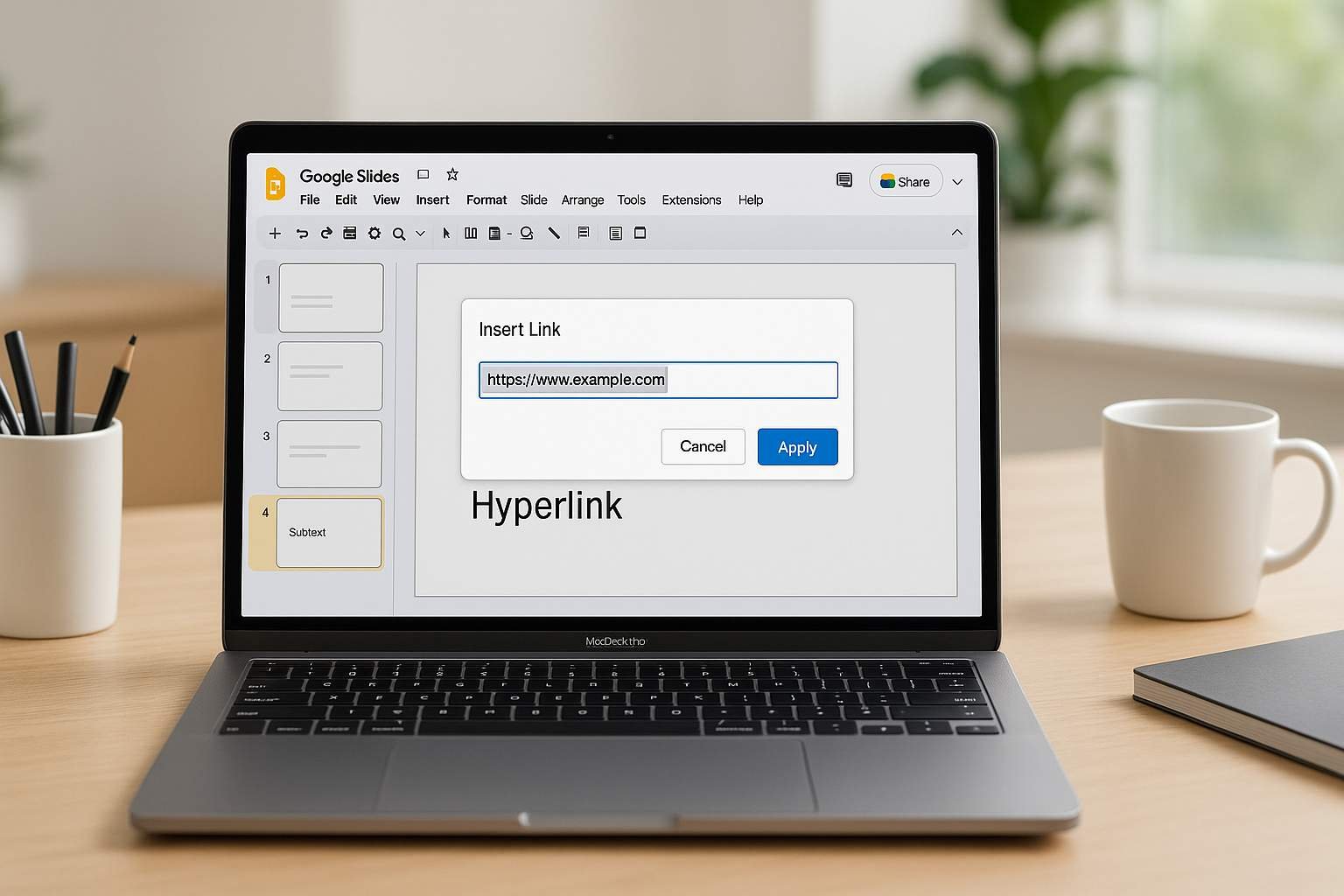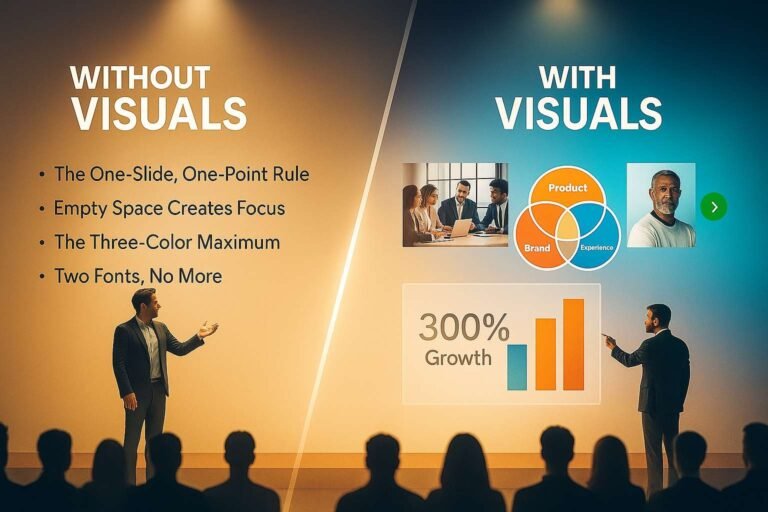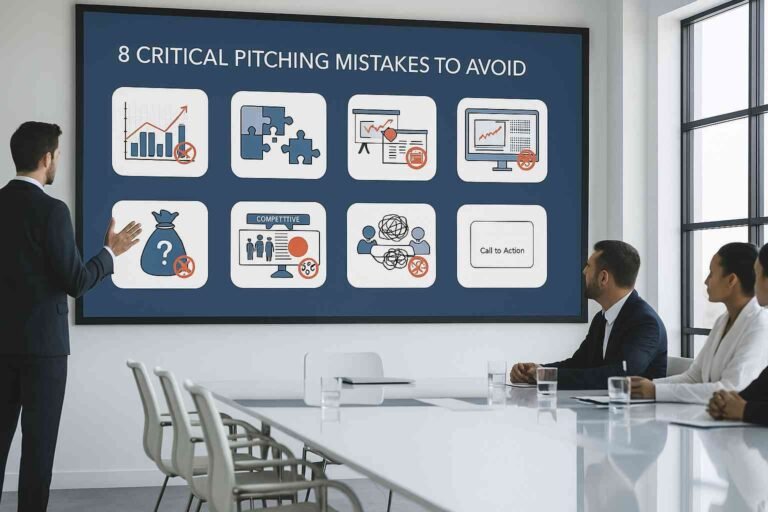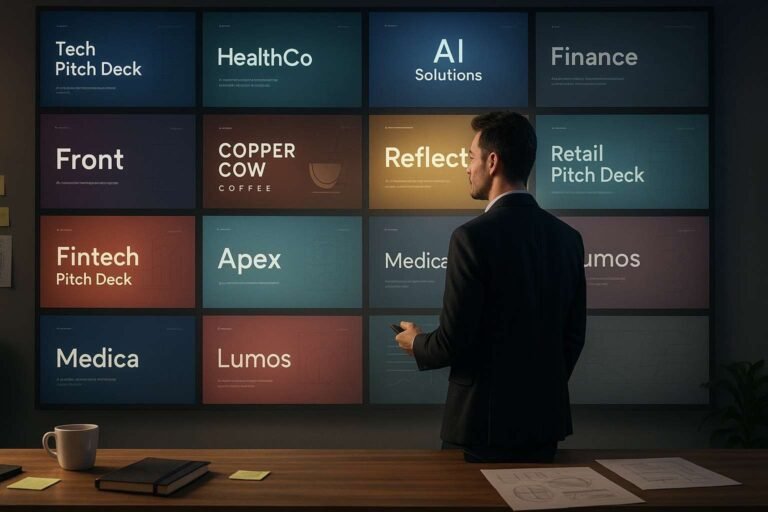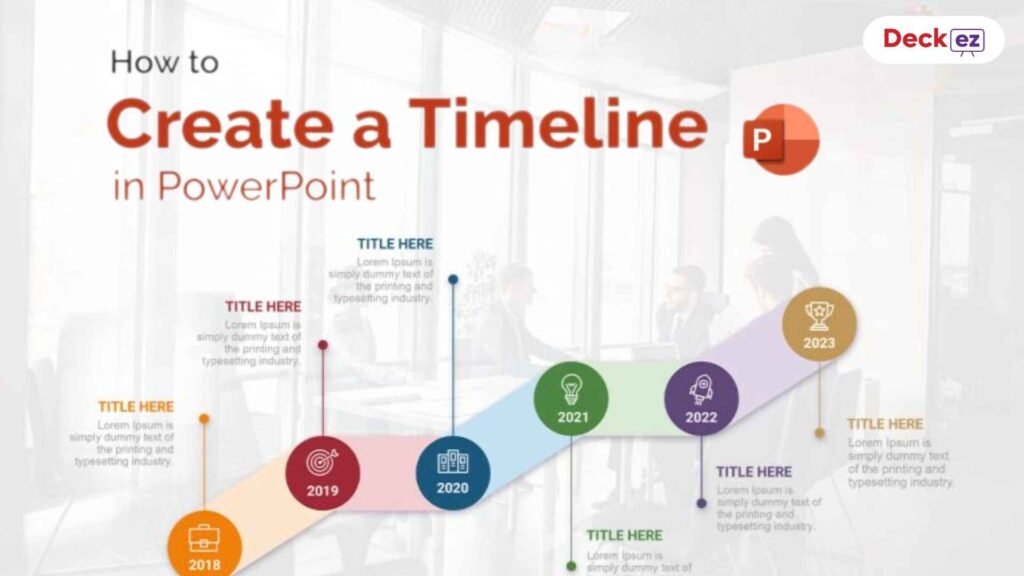Transform Your Presentations with Interactive Hyperlinks
Ever sat through a presentation where the speaker had to awkwardly switch between multiple browser tabs or documents? It’s distracting and breaks the flow completely. What if you could seamlessly navigate between different resources, slides, and external content without ever leaving your presentation?
That’s exactly what hyperlinks in Google Slides can do for you. Whether you’re creating a business presentation, educational slideshow, or interactive portfolio, hyperlinks transform static slides into dynamic, engaging experiences that keep your audience focused and interested.
In this comprehensive guide, you’ll learn everything about inserting hyperlinks in Google Slides – from basic text links to advanced navigation techniques that will make your presentations truly professional. We’ll cover how to add links to text, images, shapes, and create interactive slide navigation that keeps your audience engaged.
What Are Hyperlinks in Google Slides?
Hyperlinks in Google Slides are clickable elements that connect your presentation to other resources. Think of them as digital bridges that can take your viewers to:
- External websites and online resources
- Other slides within your presentation
- Google Drive documents, sheets, and files
- Email addresses for instant contact
- Specific sections or bookmarks
The power of hyperlinks lies in creating interactive experiences. Instead of telling your audience “I’ll share this link later,” you can let them click and explore in real-time during your presentation.
Types of Hyperlinks You Can Create
1. External Website Links
Connect to any website, blog, or online resource. Perfect for referencing sources, directing to company websites, or providing additional reading materials.
2. Internal Slide Navigation
Create a table of contents, jump to specific sections, or build choose-your-own-adventure style presentations where viewers can navigate based on their interests.
3. Google Drive File Links
Link directly to documents, spreadsheets, or other presentations stored in your Google Drive. This keeps everything organized within your Google ecosystem.
4. Email Links
Add mailto links that automatically open the viewer’s email client with a pre-filled recipient address.
Step-by-Step Guide: How to Add Hyperlinks to Text in Google Slides
Let’s start with the most common type of hyperlink – linking text to external websites and internal slides.
Method 1: Using the Insert Menu
- Select Your Text: Highlight the specific text you want to turn into a hyperlink. For example, if you’re linking to a case study, select the phrase “view case study” rather than a whole sentence.
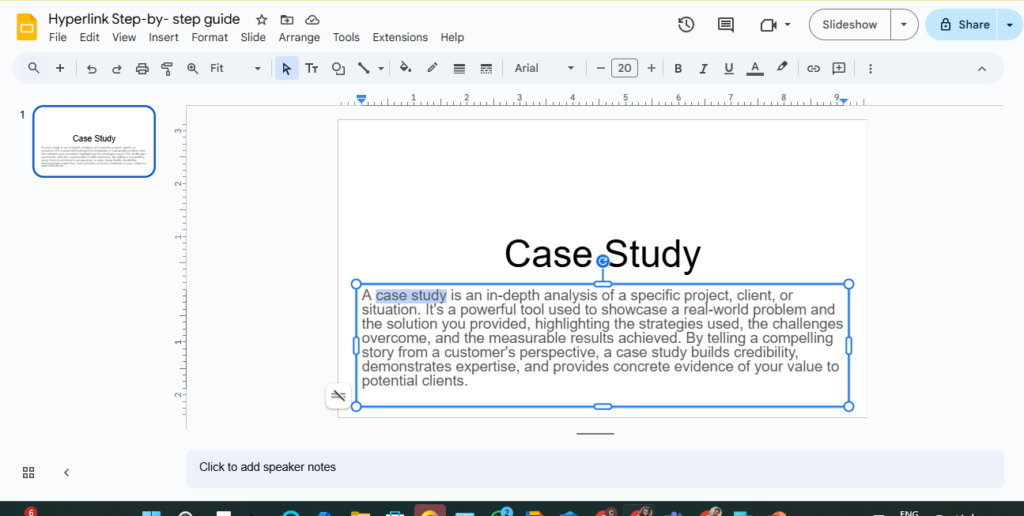
- Access the Link Option: Go to the top menu and click Insert → Link. You’ll see a small link dialog box appear next to your selected text.
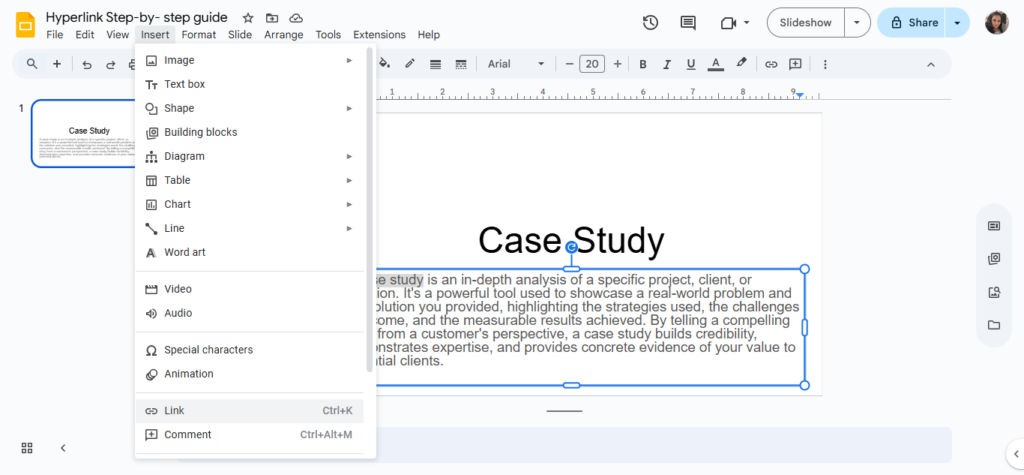
- Enter Your URL: Type or paste the complete web address (URL) you want to link to. Make sure it includes “https://” for external websites.

- Apply the Link: Click Apply or press Enter. Your text will now appear in blue and underlined, indicating it’s a clickable link.

Method 2: Using Keyboard Shortcuts
For faster linking, use these keyboard shortcuts:
- Windows/Chromebook: Ctrl + K
- Mac: Cmd + K
This opens the same link dialog box instantly after selecting your text.
Method 3: Right-Click Method
- Select your text

- Right-click to open the context menu
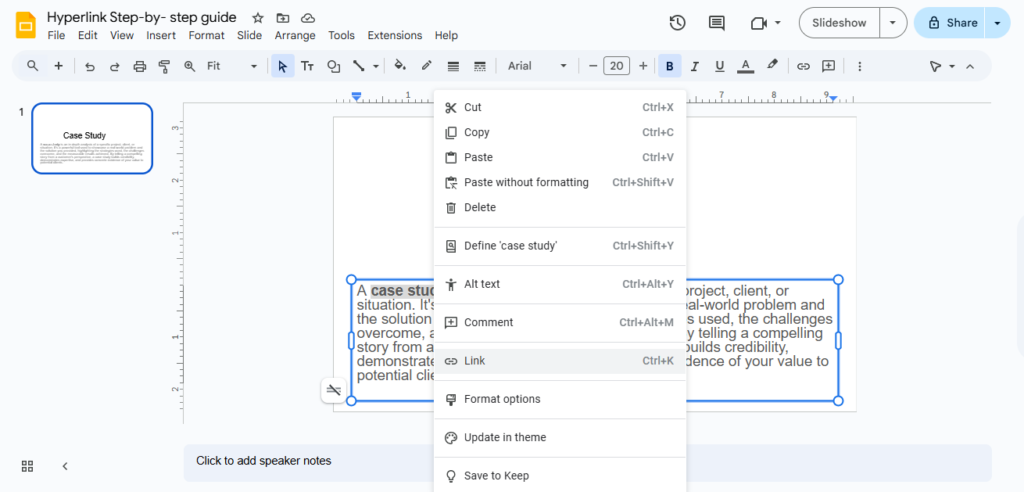
- Choose Link from the dropdown options
- Enter your URL and apply

Pro Tip: Always test your links by entering presentation mode (F5) and clicking on them to ensure they work correctly.
Adding Hyperlinks to Images
Images with hyperlinks create powerful visual call-to-actions in your presentations. Here’s how to do it:
Step-by-Step Process:
- Select Your Image: Click once on the image you want to make clickable. You’ll see selection handles around the image.
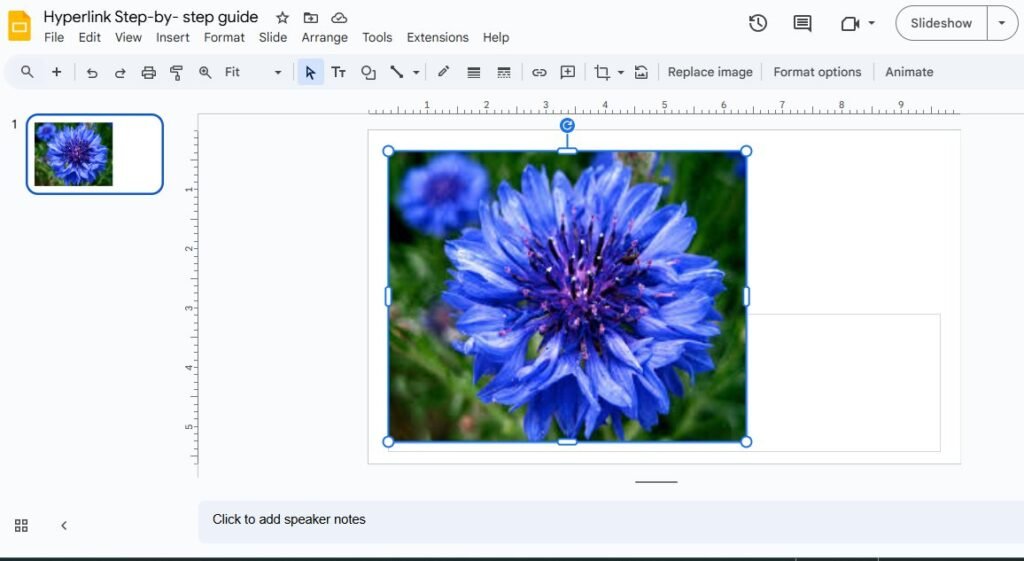
- Insert the Link: Use any of the methods above (Insert → Link, Ctrl+K, or right-click → Link).
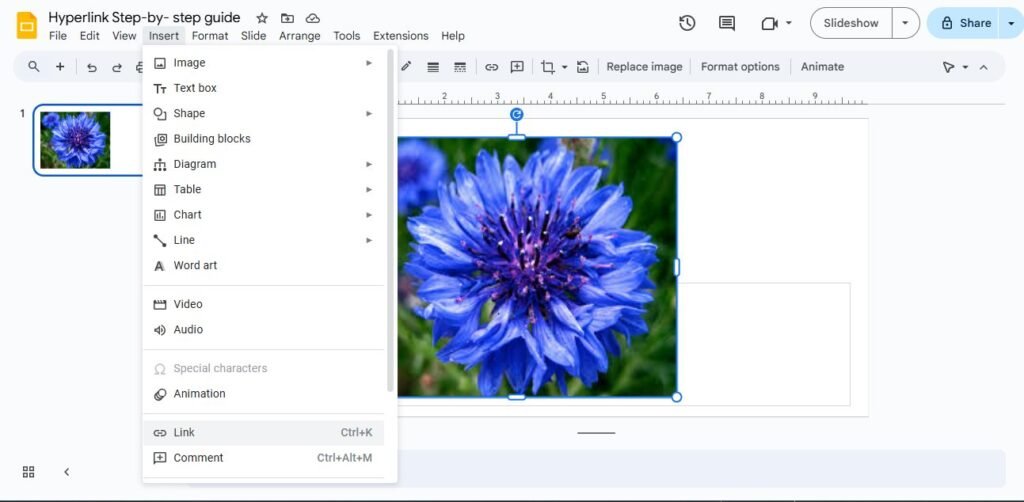
- Choose Your Destination:
- For websites: Enter the full URL
- For internal navigation: Select “Slides in this presentation” and choose your target slide
- For Google Drive files: Select the file from your drive
- Test the Link: In presentation mode, your cursor will change to a pointing hand when hovering over linked images.
Visual Tip: Consider adding a small link icon or visual indicator on images to show they’re clickable. This improves user experience and sets clear expectations.al indicator on images to show they’re clickable.
Creating Internal Navigation Between Slides
Internal linking is where Google Slides truly shines for interactive presentations. You can create sophisticated navigation systems that rival professional websites.
Building a Table of Contents
- Create Your Contents Slide: List all your main sections or topics
- Link Each Item: Select each topic title and use Ctrl+K to open the link dialog
- Choose Slide Destination: In the link dialog, select “Slides in this presentation”
- Pick Your Target Slide: Choose the slide number or use the thumbnail preview to select the correct destination
Creating Navigation Buttons
For professional presentations, create consistent navigation buttons:
- Insert Shapes: Use Insert → Shape to add buttons, arrows, or geometric shapes
- Add Text: Double-click shapes to add labels like “Next Section,” “Back to Menu,” or “Contact Us”
- Apply Links: Link each shape to its appropriate destination
- Style Consistently: Use the same colors, fonts, and sizes for all navigation elements
Advanced Navigation Techniques
Breadcrumb Navigation: Add small linked elements showing the current section Skip Links: Let viewers jump over content that might not be relevant to them Return Buttons: Always provide a way to get back to main sections or the beginning
Hyperlinking Shapes and Objects
Any element in Google Slides can become a hyperlink, not just text and images:
Linking Shapes:
- Select your shape (rectangle, circle, arrow, etc.)
- Apply the link using Ctrl+K or Insert → Link
- Choose your destination
Linking Text Boxes:
- Select the entire text box (not the text inside)
- Add your hyperlink
- The entire box becomes clickable
Creative Applications:
- Interactive Buttons: Create professional-looking call-to-action buttons
- Clickable Diagrams: Make flowchart elements interactive
- Hidden Links: Use transparent shapes over images to create custom clickable areas
Best Practices for Hyperlinks in Presentations
Visual Design Guidelines
Make Links Obvious: Use consistent styling for all hyperlinks. The default blue, underlined text is recognizable, but you can customize colors to match your brand while maintaining clarity.
Provide Visual Cues: Use icons, arrows, or other indicators to show something is clickable, especially for images and shapes.
Test Color Accessibility: Ensure your link colors work for colorblind viewers and have enough contrast against backgrounds.
User Experience Tips
Use Descriptive Link Text: Instead of “click here,” use specific phrases like “view our portfolio” or “download the report.” This is better for accessibility and SEO.
Group Related Links: If you have multiple resources, consider creating a dedicated “Resources” slide rather than cluttering individual slides.
Provide Context: Let viewers know where links will take them (“opens in new window,” “PDF download,” “external website”).
Technical Considerations
Check Link Validity: Always verify that your links work before presenting. Broken links during presentations look unprofessional.
Consider Internet Connectivity: Have backup plans for presentations in locations with poor internet access.
Mobile Compatibility: If viewers might access your presentation on mobile devices, ensure your links work across different platforms.
Troubleshooting Common Hyperlink Issues
Links Not Working in Presentation Mode
Problem: Links work in edit mode but not during the actual presentation.
Solution: Make sure you’re in full presentation mode (F5 or present mode) rather than just previewing slides.
Formatting Issues
Problem: Link text appears in wrong colors or loses formatting.
Solution:
- Select the linked text
- Use the text color tool to manually adjust
- Ensure your theme’s hyperlink colors are properly set
External Links Opening in Same Tab
Problem: External links replace your presentation instead of opening in new windows.
Solution: This is normal behavior in presentation mode. Viewers can use their browser’s back button to return to your presentation.
Mobile Viewing Problems
Problem: Links don’t work properly on mobile devices.
Solution: Test your presentation on mobile devices before important presentations. Some complex interactions may not translate perfectly to touch interfaces.
Advanced Hyperlink Features
Creating Email Links
To add clickable email addresses:
- Select your text (like “Contact us”)
- In the link dialog, enter: mailto:yourname@company.com
- This automatically opens the viewer’s email client with your address pre-filled
Linking to Specific Slides by URL
You can create direct links to specific slides:
- Open your presentation
- Navigate to the target slide
- Copy the URL from your browser
- Use this URL in other presentations or documents
Using Google Drive Integration
Link directly to related files in your Google Drive:
- In the link dialog, select “Search Google Drive”
- Choose from recent files or search for specific documents
- This keeps everything within your Google ecosystem
Creative Applications and Use Cases
Interactive Portfolio Presentations
Create portfolio presentations where viewers can:
- Jump to different project categories
- View detailed case studies
- Access live websites or demos
- Contact you directly via email links
Educational Interactive Lessons
Build learning experiences with:
- Chapter navigation
- Links to external resources and readings
- Interactive quizzes (linking to Google Forms)
- Reference materials and sources
Business Presentation Enhancement
Professional presentations benefit from:
- Direct links to product demos
- Contact information for follow-ups
- Related case studies and testimonials
- Company website and social media integration
When designing presentations for business purposes, consider leveraging presentation design services to ensure your hyperlinked elements align with your brand and communication goals.
Sales and Marketing Applications
- Product catalog presentations with direct ordering links
- Social proof through testimonial videos
- Instant access to pricing and contact forms
- Integration with CRM and marketing tools
Measuring Hyperlink Effectiveness
Tracking Engagement
While Google Slides doesn’t provide built-in analytics, you can:
- Use shortened URLs (bit.ly, tinyurl) to track clicks
- Create landing pages specifically for presentation traffic
- Ask for feedback about which resources viewers found most valuable
Improving Based on Feedback
- Monitor which links get used most frequently
- Update or remove links that don’t provide value
- Add new resources based on audience questions and interests
Security and Privacy Considerations
Safe Linking Practices
- Always verify external links before adding them
- Avoid linking to sites with security warnings
- Be cautious about linking to content that might change or disappear
- Consider the privacy implications of external tracking
Professional Boundaries
- Ensure all linked content aligns with your professional image
- Double-check that external sites are appropriate for your audience
- Have alternatives ready if external content becomes unavailable
For presentations requiring the highest level of professionalism, working with experienced investor pitch deck designers can ensure your hyperlink strategy supports your overall presentation goals.
Integration with Other Google Tools
Google Forms Integration
Create interactive presentations that collect feedback:
- Link to feedback forms
- Embed registration forms
- Gather questions for Q&A sessions
Google Sheets and Data
- Link to live data dashboards
- Connect to updated reports and charts
- Provide access to detailed datasets
YouTube and Video Integration
While you can embed videos directly, hyperlinks to YouTube content:
- Allow viewers to watch at their own pace
- Provide access to full-length versions
- Enable sharing and commenting
Future-Proofing Your Hyperlinked Presentations
Maintaining Link Health
- Regularly check and update external links
- Keep internal navigation current as presentations evolve
- Document important links for easy maintenance
Staying Updated with Google Slides Features
Google regularly updates Slides with new features. Stay informed about:
- New linking capabilities
- Enhanced mobile support
- Integration improvements with other Google tools
Building Sustainable Systems
Create templates and standards for:
- Consistent link styling across presentations
- Navigation patterns that work across different presentation types
- Documentation for team members who might edit presentations
Ready to Transform Your Presentations?
Hyperlinks in Google Slides aren’t just a technical feature – they’re a powerful tool for creating engaging, interactive presentations that keep your audience involved and provide real value. Whether you’re building educational content, business presentations, or creative portfolios, mastering hyperlinks opens up endless possibilities for better communication.
Start with simple text links to build your confidence, then gradually incorporate more advanced techniques like internal navigation and multimedia integration. Remember, the best hyperlinked presentations feel natural and intuitive – your audience should never feel confused about where a link might take them.
The key to success is planning your hyperlink strategy as part of your overall presentation design. Think about your audience’s journey through your content and how links can enhance rather than distract from your main message.
Ready to explore more presentation design insights and tips? Check out our comprehensive blog collection for more ways to elevate your presentation skills.
Frequently Asked Questions
Can I add hyperlinks to text in Google Slides on mobile devices?
Yes, you can add hyperlinks on mobile devices through the Google Slides app. Tap and hold the text to select it, then tap the “Link” option that appears. The process is slightly different from desktop but includes all the same functionality for external links, internal slide navigation, and Google Drive files.
How do I change the color of hyperlinks in Google Slides?
To change hyperlink colors, select the linked text and use the text color tool in the toolbar. For consistency across your presentation, you can also modify the theme’s hyperlink colors by going to Slide → Edit theme, then adjusting the color palette. This ensures all new hyperlinks use your preferred colors automatically.
Can I create hyperlinks that open in new windows during presentations?
During presentation mode, external hyperlinks will typically open in the same browser window, replacing your presentation. This is standard behavior for presentation software. Viewers can use their browser’s back button to return to your presentation, or you can advise them to right-click links and choose “Open in new tab” if needed.
Is there a way to remove hyperlinks without deleting the text?
Yes, to remove a hyperlink while keeping the text, select the linked text and press Ctrl+K (or Cmd+K on Mac) to open the link dialog. Then click the “Remove link” option, or you can right-click the linked text and select “Remove link” from the context menu. The text will remain but lose its hyperlink formatting and functionality.
How many hyperlinks can I add to a single Google Slides presentation?
There’s no specific limit to the number of hyperlinks you can add to a Google Slides presentation. However, for optimal performance and user experience, be strategic about your hyperlink usage. Too many links can make presentations confusing and slow to load. Focus on adding links that genuinely enhance your presentation’s value and support your key messages.

